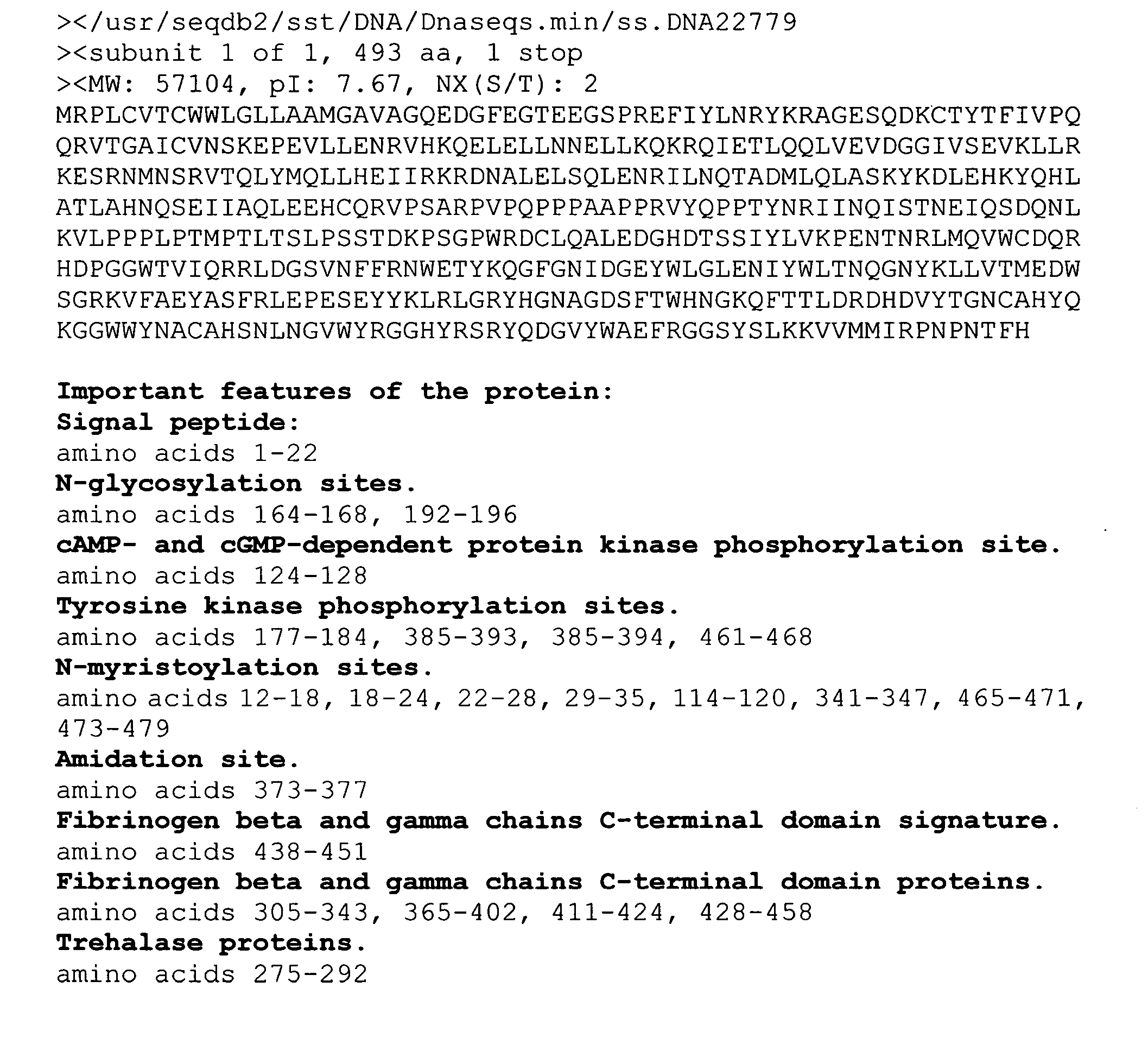Secreted and transmembrane polypeptides and nucleic acids encoding the same
a technology of applied in the field of secreted and transmembrane polypeptides and nucleic acids encoding the same, can solve the problems of not manifesting clinical symptoms, problems with diagnostic techniques, limited mcp-1 targets, etc., and achieve the effect of facilitating viral infection
- Summary
- Abstract
- Description
- Claims
- Application Information
AI Technical Summary
Benefits of technology
Problems solved by technology
Method used
Image
Examples
example 1
Extracellular Domain Homology Screening to Identify Novel Polypeptides and cDNA Encoding Therefor
[0475] The extracellular domain (ECD) sequences (including the secretion signal sequence, if any) from about 950 known secreted proteins from the Swiss-Prot public database were used to search EST databases. The EST databases included public databases (e.g., Dayhoff, GenBank), and proprietary databases (e.g. LIFESEQ™, Incyte Pharmaceuticals, Palo Alto, Calif.). The search was performed using the computer program BLAST or BLAST-2 (Altschul et al., Methods in Enzymology 266:460-480 (1996)) as a comparison of the ECD protein sequences to a 6 frame translation of the EST sequences. Those comparisons with a BLAST score of 70 (or in some cases 90) or greater that did not encode known proteins were clustered and assembled into consensus DNA sequences with the program “phrap” (Phil Green, University of Washington, Seattle, Wash.).
[0476] Using this extracellular domain homology screen, consensu...
example 2
Isolation of cDNA Clones by Amylase Screening
[0479] 1. Preparation of Oligo dT Primed cDNA Library
[0480] mRNA was isolated from a human tissue of interest using reagents and protocols from Invitrogen, San Diego, Calif. (Fast Track 2). This RNA was used to generate an oligo dT primed cDNA library in the vector pRK5D using reagents and protocols from Life Technologies, Gaithersburg, Md. (Super Script Plasmid System). In this procedure, the double stranded cDNA was sized to greater than 1000 bp and the SalI / NotI linkered cDNA was cloned into XhoI / NotI cleaved vector. pRK5D is a cloning vector that has an sp6 transcription initiation site followed by an SfiI restriction enzyme site preceding the XhoI / NotI cDNA cloning sites.
[0481] 2. Preparation of Random Primed cDNA Library
[0482] A secondary cDNA library was generated in order to preferentially represent the 5′ ends of the primary cDNA clones. Sp6 RNA was generated from the primary library (described above), and this RNA was used t...
example 3
Isolation of cDNA Clones Using Signal Algorithm Analysis
[0500] Various polypeptide-encoding nucleic acid sequences were identified by applying a proprietary signal sequence finding algorithm developed by Genentech, Inc. (South San Francisco, Calif.) upon ESTs as well as clustered and assembled EST fragments from public (e.g., GenBank) and / or private (LIFESEQ®, Incyte Pharmaceuticals, Inc., Palo Alto, Calif.) databases. The signal sequence algorithm computes a secretion signal score based on the character of the DNA nucleotides surrounding the first and optionally the second methionine codon(s) (ATG) at the 5′-end of the sequence or sequence fragment under consideration. The nucleotides following the first ATG must code for at least 35 unambiguous amino acids without any stop codons. If the first ATG has the required amino acids, the second is not examined. If neither meets the requirement, the candidate sequence is not scored. In order to determine whether the EST sequence contains...
PUM
| Property | Measurement | Unit |
|---|---|---|
| Fraction | aaaaa | aaaaa |
| Volume | aaaaa | aaaaa |
| Fraction | aaaaa | aaaaa |
Abstract
Description
Claims
Application Information
 Login to View More
Login to View More - R&D
- Intellectual Property
- Life Sciences
- Materials
- Tech Scout
- Unparalleled Data Quality
- Higher Quality Content
- 60% Fewer Hallucinations
Browse by: Latest US Patents, China's latest patents, Technical Efficacy Thesaurus, Application Domain, Technology Topic, Popular Technical Reports.
© 2025 PatSnap. All rights reserved.Legal|Privacy policy|Modern Slavery Act Transparency Statement|Sitemap|About US| Contact US: help@patsnap.com



